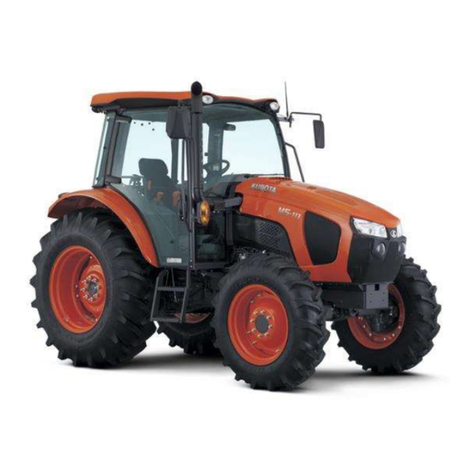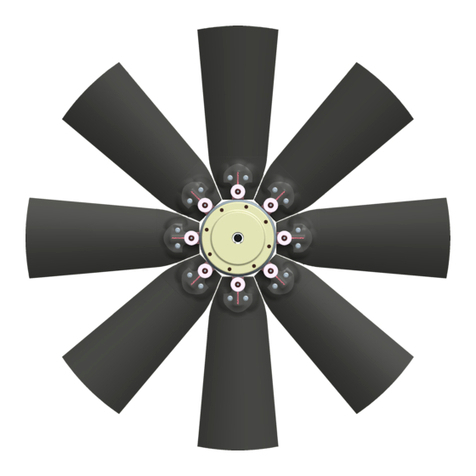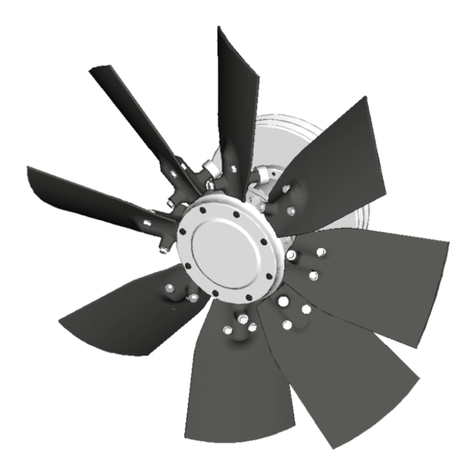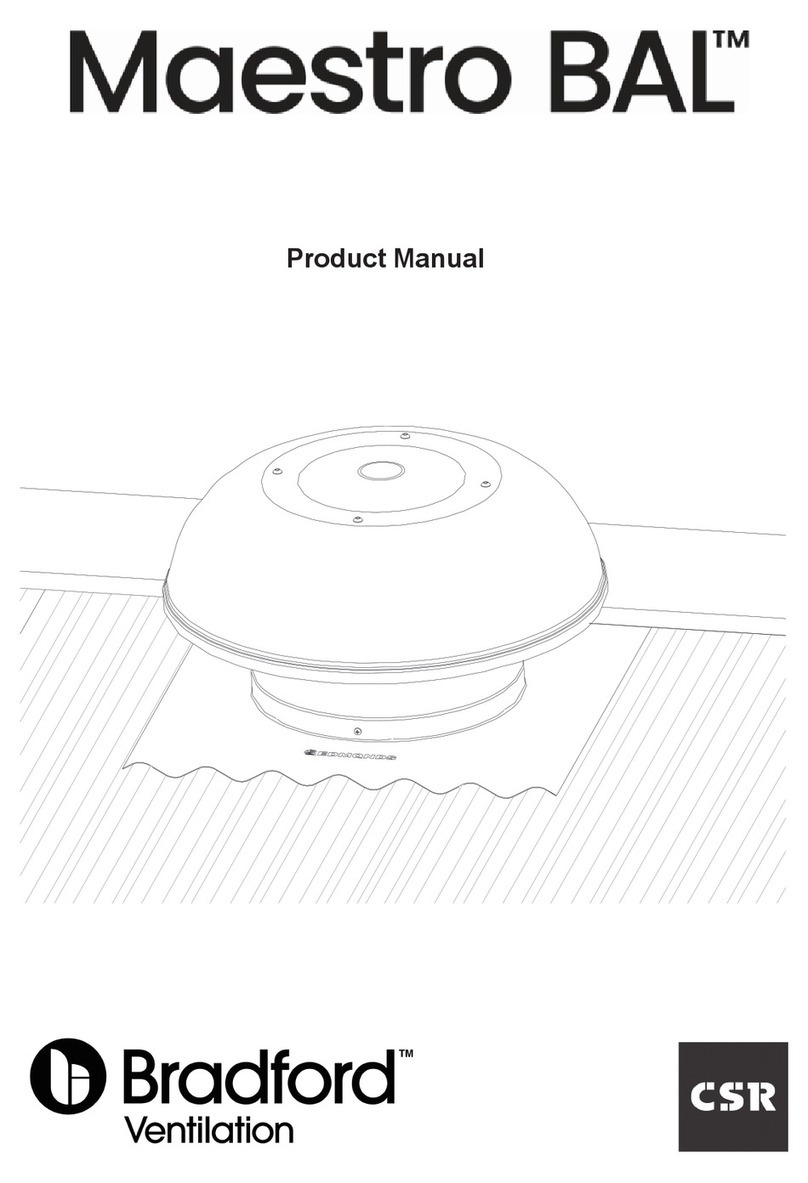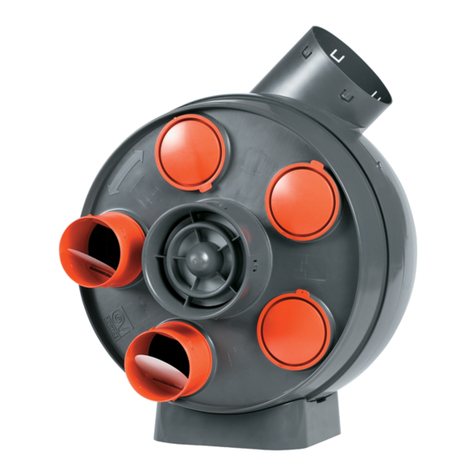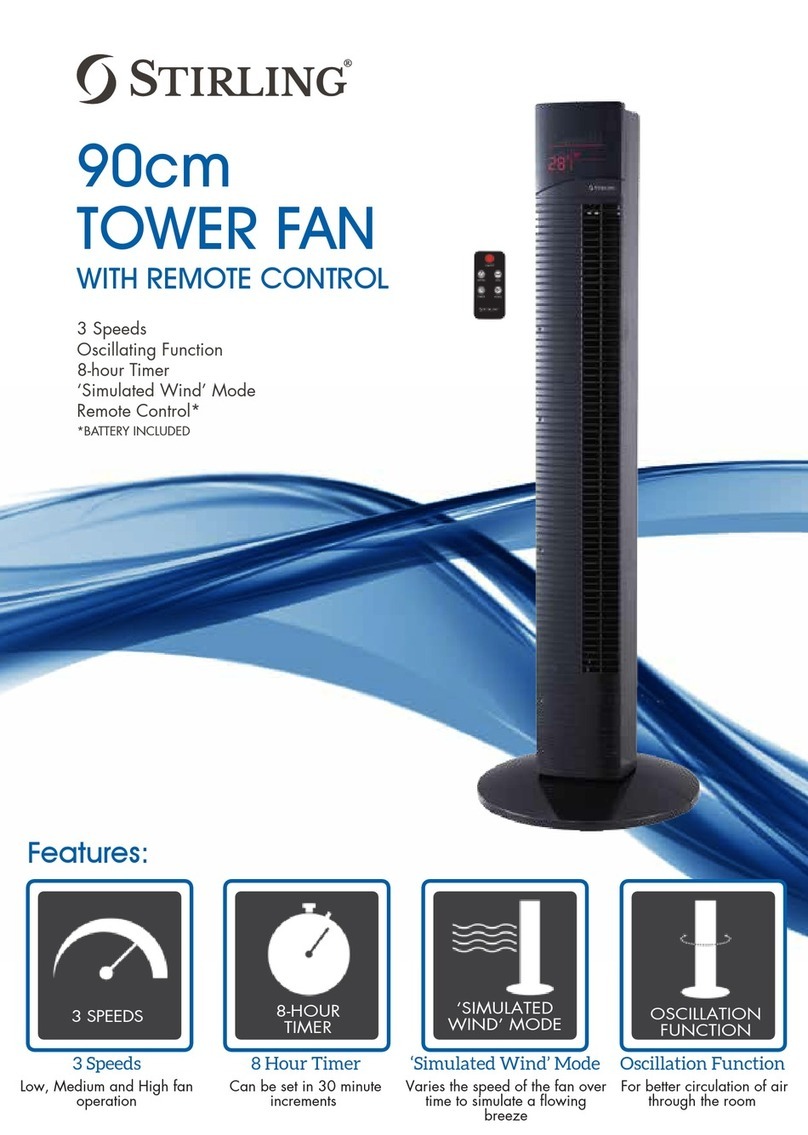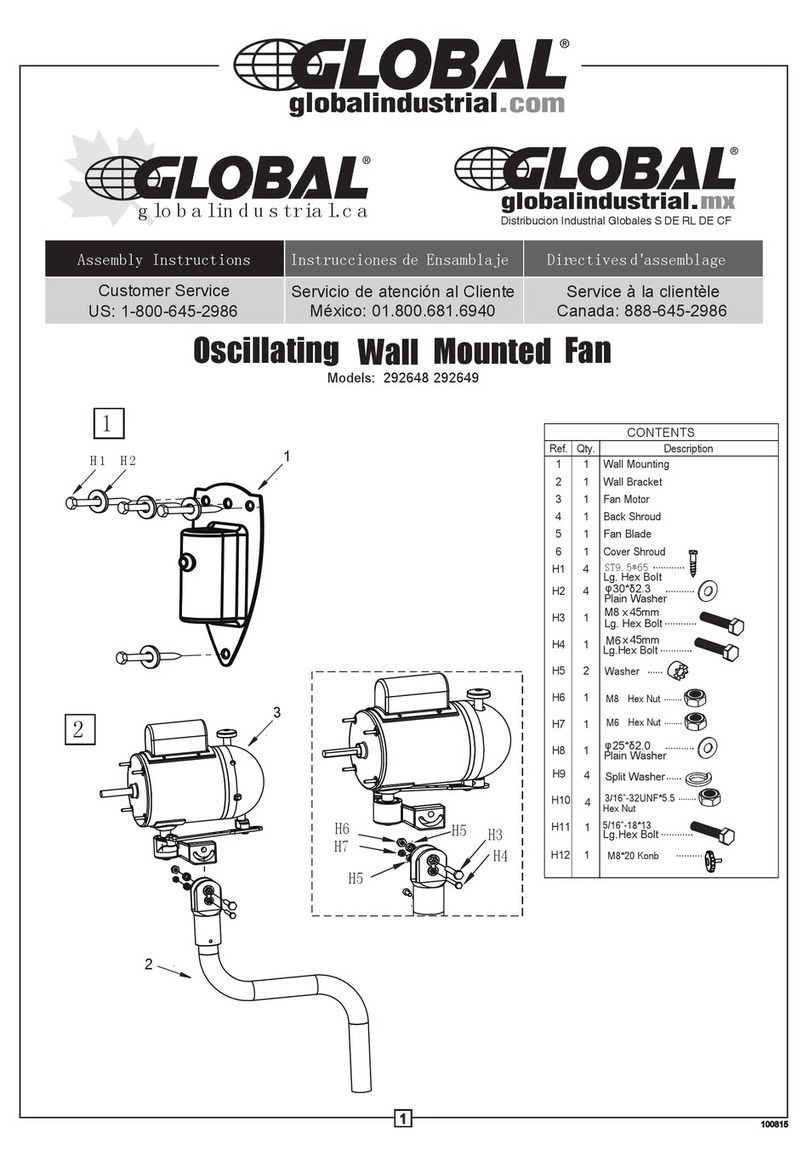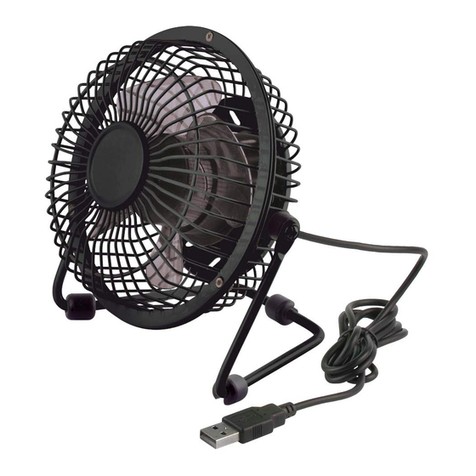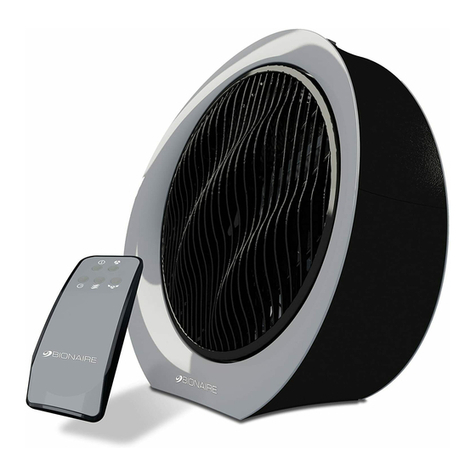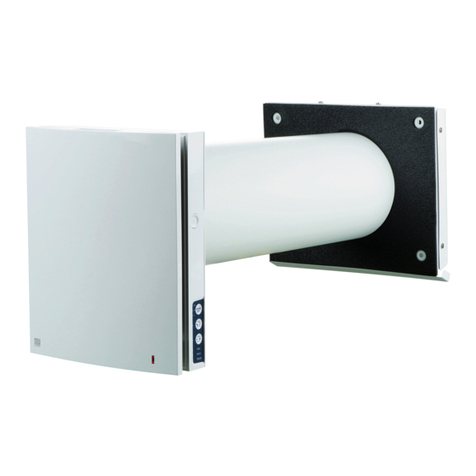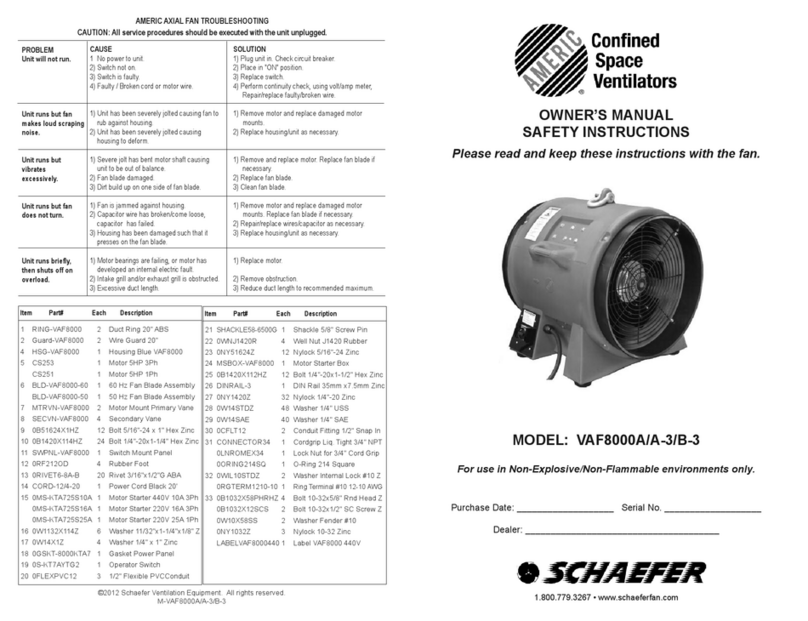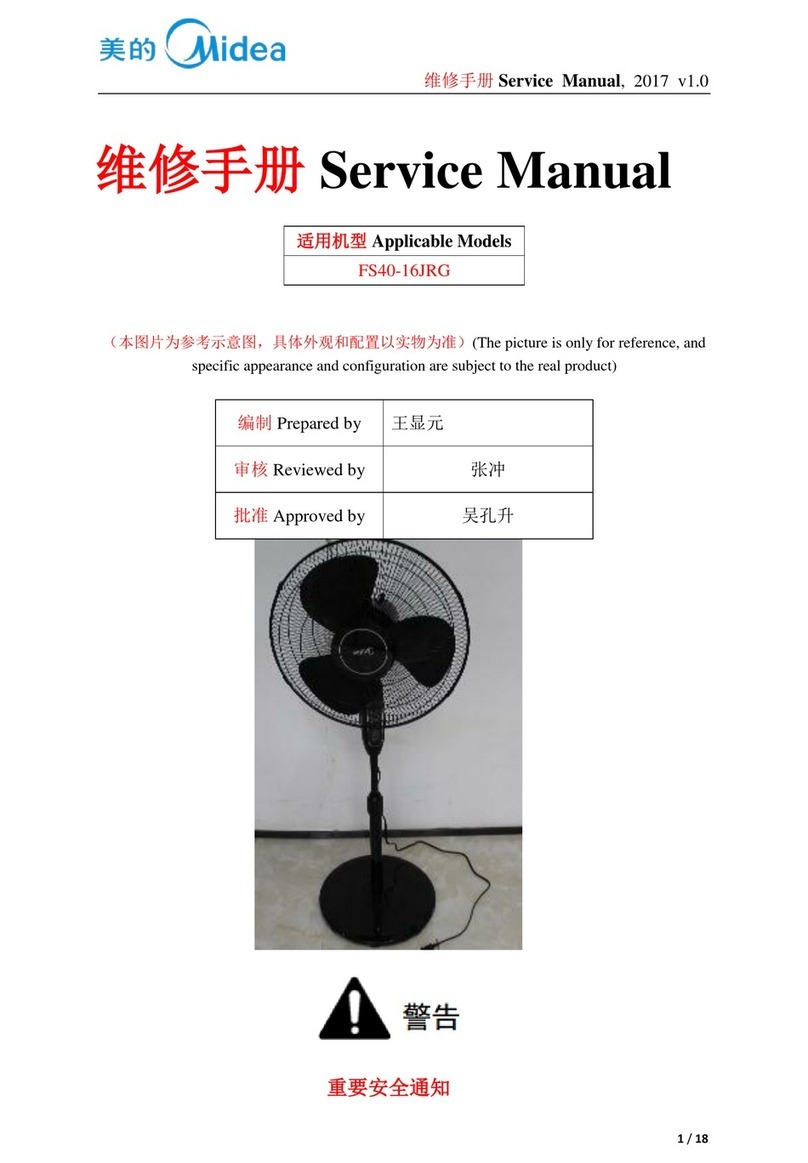Flexxaire TAC1000-P series Manual

INSTALLATION AND SERVICE MANUAL FOR THE
TAC1000-P FAN SERIES (PNEUMATIC CONTROL)
TAC1000-H FAN SERIES (HYDRAULIC CONTROL)
Publication No. 01553
Revision 8
Printed in Canada

1.1 INTRODUCTION
This manual (P/N 01553) is produced to assist in the in-
stallation, operation and maintenance of Flexxaire®
TAC1000-P and TAC1000-H Series Fan Systems.
Flexxaire has made every effort to ensure that the infor-
mation contained in this manual is correct and complete at
the time of printing. Flexxaire®will assume no responsibil-
ity for any errors or omissions. If you have any questions
regarding this manual or any other document provided with
your fan system, please contact:
Flexxaire
Product Support Department
10430-180 Street
Edmonton, Alberta, Canada
T5S-1C3
Phone: 780-483-3267
Fax: 780-483-6099
1.2 IMPORTANT SAFETY INFORMATION
The safety information in this publication is to be used in
conjunction with the safety information supplied from the
original machine manufacturer. Please refer to all safety
information supplied, prior to doing any work on the fan
assembly or any other component to assure safety.
Improper operation, maintenance or repair of this
product can be dangerous and could result in injury
or death.
Always use Flexxaire parts and components or Flexxaire
approved parts and components. The use of unapproved
parts and/or components may void the 1-year warranty.
Do not operate or perform any maintenance on this
product until you have read and understand the op-
eration and maintenance information. Please con-
tact Flexxaire or an approved dealer for any infor-
mation that you may require.
The person(s) servicing the product may be unfa-
miliar with many of the systems or components on
the product. This makes it important to use caution
when performing any type of service work. A
knowledge of the product and/or its components is
important before the removal or disassembly of any
component.
1.2.1 PROTECTIVE EQUIPMENT
Always wear protective glasses, protective shoes and any
other protective equipment as required by job conditions
when working around this product.
1.2.3 SPRING LOADED FAN HUB
The hub assembly is spring loaded. If disassembly of the
hub is required, take caution that you are well protected
from the hub’s release which may be sudden and pose an
impact related injury. Also make sure that the internal
pressure is released. Consult the pneumatic or hydraulic
control instructions.
1.2.3 HOT FLUIDS AND PARTS
To avoid burns, be alert for hot parts on the assembly or
the machine that have just been stopped and have hot flu-
id in lines, tubes and compartments.
1.3 PRODUCT SUPPORT
The Product Support Department provides technical sup-
port, information on fan installation and maintenance,
parts, instruction manuals, and is responsible for warranty
administration. Contact the Product Support Department
for any problems that this technical manual does not ad-
dress.
Phone: 780-483-3267
Monday to Friday 8:00 a.m to 4:00 p.m. MST
1.4 FAN SPECIFICATIONS
The following needs to be considered prior to the installa-
tion of the Flexxaire Fan System. If your situation is listed
in this section, DO NOT INSTALL THE FAN. Damage
and/or injury may occur.
1.4.1 MOUNTING
WARNING: This fan is not designed to be mounted onto
a crank shaft or crank shaft pulley. Torsional vibration
from crankshafts will damage the fan and could result in
machine damage and serious injury.
Printed in Canada TAC1000 Manual June 19, 2013 Page 1

Printed in Canada TAC1000 Manual June 19, 2013 Page 2
1.4.2 FAN BLADE TIP SPEED
WARNING: The fan system must not exceed a blade tip
speed of 20,000 feet/minute. Exceeding this speed may
cause damage to and/or failure of the fan, which in turn
may cause injury or death, or less importantly, damage to
the radiator and surrounding equipment.
To calculate the blade tip speed, use the following formula:
Fan Diameter (Inches) X 3.14 X Fan RPM
12
If your calculated tip speed exceeds 20,000 ft/min, contact
Flexxaire directly, prior to installation. It is important to
use Fan RPM and NOT engine RPM.
1.5 FAN OVERVIEW
Flexxaire’s TAC1000 fan systems are designed to minimize
overheating caused by debris plugged radiators, screens
and guards, and reduce overcooling in low ambient tem-
peratures. The blades of the TAC1000 vary pitch, not
speed, to control air flow and direction.
How your TAC1000 works:
The TAC1000-P is a pneumatically actuated variable pitch
fan. The TAC1000-H is a hydraulically actuated variable
pitch fan. The blades are held in full pitch by a heavy
spring. As pneumatic (or hydraulic) pressure is applied to
the control line, the pitch of the blade is reduced and then
reversed. When the pressure is released, the fan blades
return to their default position (See below). The TAC1000
has a number of inherent features:
1. Fail Safe Operation: The blades are spring loaded into
the default full pitch position. If the fan loses pressure, the
fan will default to full pitch and act like a fixed pitch fan
giving maximum cooling.
2. Depending on the control kit ordered (see section 2.0),
the fan can be run in a neutral pitch (or any pitch in be-
tween) to solve overcooling problems and save horsepower
and fuel.
When purging, there are no horsepower spikes in fact the
horsepower drops off as you pass through neutral pitch,
then slowly builds as pitch increases.
2.0 CONTROL KITS
Due to the variability of machines that the TAC1000 fan
may be installed on, the fan does not include any control
components. All of Control Kits are available in 12V and
24V configurations. Contact Flexxaire or your dealer for
availability.
Flexxaire has a number of different control kits available to
suit a wide range of applications:
2.0.1 PNEUMATIC CONTROL:
-2 Position kit (Manual Purge)
-2 Position kit with timer (Manual and Auto Purge)
-Infinitely Variable Pitch Controller (IVP fan control)
-Each kit is available with or without an air compressor.
2.0.2 HYDRAULIC CONTROL:
-2 Position kit (Manual Purge)
-2 Position kit with timer (Manual and Auto Purge)
-Infinitely Variable Pitch Controller (IVP fan control)

Printed in Canada TAC1000 Manual June 19, 2013 Page 3
1. Blade Assembly
2. Hub Assembly
3. Blade Counter Weight
4. Pressure line (Pneumatic or
Hydraulic)
5. Mounting Adapter Bolts
6. Mounting Adapter
7. Hub Mounting Bolts
Figure 1: Fan Components
MAJOR COMPONENTS:
2.1 MAJOR COMPONENTS
The TAC1000 Fan Assembly can be identified by several
external components as shown in Figure 1. Use this dia-
gram for terminology and major component identification.
(This figure is of a TAC1000-P, but the major components
are the same between the TAC1000-P and TAC1000-H
fans.)
2.2 EXISTING FAN REMOVAL
The following is a general description for the removal of an
existing fan and the installation of a Flexxaire TAC1000
Fan.
A. Remove fan guards and safety equipment to gain
access to the existing fan.
B. Loosen belt(s) and remove existing fan hardware as
required.
C. Clean mounting surface of fan drive
2.3 INSTALLATION
2.3.1 Mounting Adapters
The TAC1000 is supplied with a pre-machined mounting
adapter. Pre-machined mounting adapters are machined
for your pilot and bolt circle.
For some applications, a wider 2-piece adapter may be
used, and the necessary hardware for assembling the 2
parts together will be included. This 2-piece adapter may
be pre-assembled.
2.3.2 Fan Position
Ideally the fan should be centered in the shroud (30-70%
immersion is acceptable). Optimum placement varies with
each application. This may require modification or removal
of the fan spacer or modification of the shroud.
See Figure 2.

Printed in Canada TAC1000 Manual June 19, 2013 Page 4
Figure 2
A. Install the Flexxaire supplied adapter plate using
bolts from the original fan. If the bolt length needs
to be changed, use an equivalent or better grade of
bolt. Follow original equipment manufacturers
torque and thread locking specifications when in-
stalling the mounting adapter to the fan drive.
B. Measure axial and radial runout of the installed
adapter. Runout should not exceed 0.005” (0.127
mm) in either direction. Refer to Figure 3.
Figure 3: Adapter Plate Mounting
C. Remove the shipping plug from the rear of the fan.
Place the TAC1000 fan onto the adapter plate and
torque the M8 bolts, supplied loose in fan kit, to 21
Ft-Lbs (28 N.m). Do not use thread locking com-
pound. Refer to Figure 4.
WARNING: Do not remove the three M8 bolts from
the rear of the Flexxaire Fan. The TAC1000 fan is
spring loaded; improper removal of these bolts could
result in injury.
Figure 4: Fan Mounting
Refer to Figure 5 on page 5 for proper clearance for fan
rotary union and blade clearance.

Printed in Canada TAC1000 Manual June 19, 2013 Page 5
Figure 5
WARNING: Failure to have correct blade clearance
could result in blade contact that can cause extensive
damage to people and equipment.
WARNING: Failure to have the correct clearance for
the rotary union could result in premature failure of the
rotary union and/or damage to objects contacting the
rotary union.
3.0 PNEUMATIC LINE INSTALL
A. Drill a hole in the fan shroud to allow the flexible
nylon hose to be routed into the engine compart-
ment. Secure the hose using hose clamps.
B. Attach the incoming ¼” O.D. air line to the front of
he fan.
C. Ensure that the hose clears all parts of the fan. If
possible, secure the hose away from the fan. Com-
mon ways to do this are to zip tie the hose to the
radiator core, or to attach it to the radiator frame or
the bolted flanges between the radiator cores.
WARNING: Do not secure the air line so tight as to
cause a side load on the rotary union. Failure of the
bearings could result.
WARNING: Do not secure the air line so loose that
the hose could contact the blades due to sudden air
reversal, vibration, etc...
D. Ensure you have proper clearance for the rotary un-
ion and blades to nearest contact point(s). Please
refer to Figure 5 for more information.
E. Install the pneumatic control. Follow the instructions
included with the control kit. If you did not purchase
a kit from Flexxaire, see section 3.2 for pneumatic
specifications.
F. Rotate the fan by hand and check for obstructions.
A final check will be required once the air supply has
been connected to the fan. A minimum of 90 PSI
(620 kPa) will be required to fully reverse the
blade pitch. Spin the fan by hand with the blade
pitch reversed and check for obstructions.
G. Tighten the fan belts and replace all the fan guards
and safety equipment.
H. Attach the “WARNING” label to the machine, on a
housing, guard, or any location near the fan where it
can be easily seen.

Printed in Canada TAC1000 Manual June 19, 2013 Page 6
3.2 PNEUMATIC SPECIFICATIONS
Flexxaire supplies a number of pneumatic control options,
but the TAC1000-P can be operated using any air source
that meets the general specifications listed below. If your
machine has air on board then this source will be available.
If not, then a compressor will be required.
General Specifications:
Full Pitch (default position): 0 psi (0 kPa)
Neutral Pitch (Stop air position): ~60 psi (413 kPa)
Reverse Pitch (Purge position): 90 psi (620 kPa)
Max intermittent pressure: 110 psi (758 kPa)
Max continuous pressure: 90 psi (620 kPa)
4.0 HYDRAULIC LINE INSTALL
A. Drill a hole in the fan shroud to allow the flexible
hydraulic hose to be routed into the engine compart-
ment. Secure the hose using hose clamps.
B. No exterior bracing should be used to prevent the
rotary union from rotating. It is imperative that a
flexible connection be used.
C. The fan is supplied with the hydraulic line attached.
Connect the line to the hydraulic source that will be
used to operate the fan. Use thread sealant on all
connections.
D. Ensure that the hose clears all parts of the fan. If
possible, secure the hose away from the fan. Com-
mon ways to do this are to zip tie the hose to the
radiator core, or to attach it to the radiator frame or
the bolted flanges between the radiator cores.
E. Rotate the fan by hand and check for obstructions.
A final check will be required once the hydraulic hose
has been connected to the hydraulic source. A mini-
mum of 450 PSI (3 MPa) will be required to fully re-
verse the blade pitch. Spin the fan by hand with the
blade pitch reversed and check for obstructions. Use
Figure 5 on Page 5 for clearance between the blades
and any stationary objects.
F. Tighten the fan belts and replace all the fan guards
and safety equipment.
G. Attach the “WARNING” label to the machine, on a
housing, guard, or any location near the fan where it
can be easily seen.
WARNING: Do not secure the hydraulic hose so tight
as to cause a side load on the rotary union. Failure of
the bearings could result.
WARNING: Do not secure the hydraulic hose so
loose that the hose could contact the blades due to
sudden air reversal, vibration, etc..
H. Install the hydraulic control valve. Follow the in-
structions included with the control kit. If you did
not purchase a kit from Flexxaire, see section 4.1 for
hydraulic specifications.
4.1 HYDRAULIC SPECIFICATIONS
Flexxaire supplies a number of hydraulic control options,
but the TAC1000-H can be operated using any hydraulic
source that meets the general specifications listed below.
If your machine has hydraulics on board then this source
will be available.
General Specifications:
Full Pitch (default position): 0 psi (0 MPa)
Neutral Pitch (Stop air position): ~250 psi (1.7 MPa)
Reverse Pitch (Purge position): 450 psi (3 MPa)
Maximum allowable pressure: 1000 psi (6.9 MPa)
5.0 SERVICE AND MAINTENANCE
Flexxaire’s TAC1000 fan hub is fully sealed with o-rings,
and contains a small quantity of grease. (EP00 semi-fluid
grease) As a result, the fan itself should not require any
maintenance.
5.1 VISUAL INSPECTIONS
Under normal operating conditions TAC1000 fans do not
require any scheduled maintenance and are built to provide
thousands of hours of trouble free service. In moderate to
extreme operating conditions a visual inspection of the
moving parts in recommended from time to time to safe-
guard against fan blade damage which could lead to equip-
ment downtime and/or other damages.

Printed in Canada TAC1000 Manual June 19, 2013 Page 7
5.2 MECHANICAL REVIEW
Ensure that the fan fully reverses pitch. Check for air leaks
in the rotary union. Check that the rotary union bearings
rotate smoothly.
CHECK YES NO
Does fan rotate in default
and full reverse pitches? □□
Is the pressure line se-
cured away from the
blades?
□□
Has the side load on the
pressure line been mini-
mized?
□□
Is the pressure line flexible
enough to accommodate
relative movement be-
tween the radiator and
engine?
□□
Are any of the blades
damaged? □□
Does the rotary union ro-
tate freely? □□
Are there any pressure
leaks in the system? □□
Are all screens and guards
secured? □□
Have you recorded the fan
S/N for future reference?
S/N_______________
□□
This manual suits for next models
1
Table of contents
Other Flexxaire Fan manuals
